Matthias Kyburz (Switzerland), Olav Lundanes (Norway) and Daniel Hubmann (Switzerland) had a very tight battle for victory in the Men’s World Orienteering Championships Middle distance 2016 in Tanum, Sweden. At the arena passage 6 minutes before the finish, the three runners were within 15 seconds with Olav Lundanes first. In the finish the gap was increased to 23 seconds – but now with Kyburz on top with Lundanes in 2nd and Hubmann in 3rd.
This analysis looks into who had the speed to win the race and the medals – and why Matthias Kyburz could climb to the very top of the podium at the end of the day with a Gold medal around his neck. As the illustrations and analysis below will show, Thierry Gueorgiou (France), Gustav Bergman (Sweden), Magne Dæhlie (Norway) and maybe Lucas Basset (France) and Oleksandr Kratov (Ukraine) had the required speed. However, too many time losses, routechoice misses and mistakes left them without medals this sunny day in Tanum.
Race development at a glance
The below splits graph shows the race development between the top runners at a glance. Not included in the splits graph is Oleksandr Kratov who had the lead until the 6th control, but who gave up after several mistakes and just took it easy in to the finish.
Daniel Hubmann takes over the lead from Kratov at the 7th control and keeps it until he takes a wrong routechoice to control 12 and makes a mistake at control 13. Here Kyburz takes over the lead. At control 18 Bergman is briefly in the lead together with Kyburz, but Bergman then gets a very bad period and loses more than 2 minutes on the last part of the course. Kyburz keeps the lead until he takes a wrong micro-routechoice to control 19. Here Lundanes takes the opportunity and opens up a lead of nearly 20 seconds which he keeps for 4 controls until he gets trapped in a green area. At control 22 Kyburz takes over the lead again, and keeps it to the finish.
This analysis focuses on these situation, but also includes other legs where top runners lose significant time or which are important for the race development.
Control 2: Dæhlie & Gueorgiou lose time
One of the biggest favourites, Thierry Gueorgiou, struggles with his orienteering already to the second control, losing 24 seconds. This is a quite short leg with routechoices which are typical for this area. Gueorgiou’s GPS-track is the one going far to the right in the illustration – it looks like a combination of direction mistake and wrong routechoice – a very shaky start by the former “King of Middle” – this is not very like him. Magne Dæhlie also has a bad start, losing 20 seconds here on a more straight route. Matthias Kyburz has one of his poorest legs here, losing 16 seconds due to a route going too far left. Oleksandr Kratov starts the race very well, also running a very good route here to the second control.
Control 3: Dæhlie loses more time
Leg 3 is a short leg which can be made quite easy if you are careful with your orienteering – yet Dæhlie does a mistake and loses another 24 seconds.
Control 4: Complex routechoice leg where several top runners lose time
The leg to control 4 is a complex routechoice leg were several of the top runners lose time; Basset, Gueorgiou, Lundanes and Dæhlie all lose 20 seconds or more to Matthias Kyburz who runs the fastest time on the leg. As you can see from the above illustration, there are three different routes which are approximately equal time-wise – right (Kyburz), straight (Hubmann) and left (Kratov). The significant timelosses of Basset, Gueorgiou, Lundanes, Dæhlie and many others is thus more about execution of the leg than picking the right route. Below you see first a comparison of most of the field on this leg, and then a separate analysis for each of the top runners who lose significant time.
Note how Gueorgiou loses most of the time on the first part of the leg where he runs approximately the same route as Kyburz – maybe due to insecurity or less offensive running? Lundanes loses time due to a mistake/detour on the first third of the leg and Dæhlie takes a bad route on the middle part of the leg.
Standings at control 4
| 1. | Oleksandr Kratov | UKR | 7:14 | (+0:00) | Total: 42:10 (30) |
| 2. | Daniel Hubmann | SUI | 7:24 | (+0:10) | Total: 37:32 (3) |
| 3. | Hannu Airila | FIN | 7:27 | (+0:13) | Total: 39:18 (8) |
| 4. | Gustav Bergman | SWE | 7:30 | (+0:16) | Total: 39:03 (7) |
| 5. | Matthias Kyburz | SUI | 7:31 | (+0:17) | Total: 37:09 (1) |
| 6. | Fredric Portin | FIN | 7:31 | (+0:17) | Total: 39:21 (10) |
| 7. | Lucas Basset | FRA | 7:43 | (+0:29) | Total: 37:51 (5) |
| 8. | Ruslan Glibov | UKR | 7:45 | (+0:31) | Total: 39:44 (13) |
| 9. | Robert Merl | AUT | 7:49 | (+0:35) | Total: 41:53 (29) |
| 10. | Olav Lundanes | NOR | 7:50 | (+0:36) | Total: 37:23 (2) |
| 11. | Pavlo Ushkvarok | UKR | 7:50 | (+0:36) | Total: 39:58 (16) |
| 12. | Miika Kirmula | FIN | 7:55 | (+0:41) | Total: 41:46 (27) |
| 13. | Peter Oberg | SWE | 7:59 | (+0:45) | Total: 39:19 (9) |
| 14. | Soren Bobach | DEN | 7:59 | (+0:45) | Total: 42:50 (35) |
| 15. | Graham Gristwood | GBR | 8:02 | (+0:48) | Total: 40:30 (19) |
| 16. | Thierry Gueorgiou | FRA | 8:03 | (+0:49) | Total: 37:44 (4) |
| 28. | Magne Daehli | NOR | 8:39 | (+1:25) | Total: 38:21 (6) |
Looking at the intermediate standings at control 4, Kratov has a 10 seconds lead ahead of Hubmann. Kyburz is at +17 seconds while Lundanes is already 36 seconds behind in 10th, Gueorgiou 49 seconds behind in 16th and Dæhlie 1:25 behind in 28th. Surprisingly shaky start by many of the top runners.
From the 4th control to the finish, Lundanes is actually the fastest (even with the mistake in the end) ahead of Kyburz, Gueorgiou and Dæhlie – only 9 seconds separating them:
| 1. | Olav Lundanes | NOR | 29:33 | (+0:00) | Total: 37:23 (2) |
| 2. | Matthias Kyburz | SUI | 29:38 | (+0:05) | Total: 37:09 (1) |
| 3. | Thierry Gueorgiou | FRA | 29:41 | (+0:08) | Total: 37:44 (4) |
| 4. | Magne Daehli | NOR | 29:42 | (+0:09) | Total: 38:21 (6) |
| 5. | Daniel Hubmann | SUI | 30:08 | (+0:35) | Total: 37:32 (3) |
| 6. | Lucas Basset | FRA | 30:08 | (+0:35) | Total: 37:51 (5) |
Control 7: Gueorgiou accelerates – Kratov out of the fight
The leg to control 7 is interesting because this is the phase in the race where Gueorgiou finds back to some of his old secrets – winning the 7th leg with 8 seconds – and running several good legs. Gueorgiou is 15 seconds faster than the next runner (Lucas Basset) between control 4 and 8. It is not easy to understand exactly why Gueorgiou is so much faster than everybody else from 6 to 7 – he probably found the flow and had the speed. This is also the place where Kratov loses his lead in the competition (losing 50 seconds at this leg) – after this Kratov is only a shadow of what he did earlier in the course.
Control 12: Crucial routechoice leg
Before the routechoice leg to control 12 Daniel Hubmann is in a clear 21 second lead ahead of Kyburz. Portin is in third with Gueorgiou and Lundanes also in the Top 6.
| 1. | Daniel Hubmann | SUI | 16:25 | (+0:00) | Total: 37:32 (3) |
| 2. | Matthias Kyburz | SUI | 16:46 | (+0:21) | Total: 37:09 (1) |
| 3. | Fredric Portin | FIN | 16:48 | (+0:23) | Total: 39:21 (10) |
| 4. | Lucas Basset | FRA | 16:50 | (+0:25) | Total: 37:51 (5) |
| 5. | Thierry Gueorgiou | FRA | 16:51 | (+0:26) | Total: 37:44 (4) |
| 6. | Olav Lundanes | NOR | 16:56 | (+0:31) | Total: 37:23 (2) |
The long leg to control 12 is the main routechoice leg in the course – a leg where many top runners chose wrong routes. Worst of the top runners is Thierry Gueorgiou who loses 32 seconds by running to the right. With this time loss he is simply too far behind to win the race. Current leader Hubmann loses 24 seconds to the best route by going too far left and struggling under the cliffs – he still retains the race lead however, as Kyburz also loses some seconds to the best split. Even Dæhlie and Basset (both do not go straight over the first small hill but use the path instead) lose significant time here. Current 3rd placed Portin loses more than 40 seconds by going nearly straight under the line.
Clearly the best routechoice is to run to the left, using the path as much as you can, and thus also reducing the climb as much as you can, as for the women’s race. The reason for so many runners taking the option to the right may be that the first hill on the route to the left might seem a little tough after all the experience the runners had with steep hills and cliffs on the training maps – this hill does however only have 10 meter climb and is climbed easily. The climbs at the middle of the leg on the rightmost variant are worse. Below are some more detailed illustrations for the complete field and for some of the top runners.
Standings at control 12
| 1. | Daniel Hubmann | SUI | 20:53 | (+0:00) | Total: 37:32 (3) |
| 2. | Matthias Kyburz | SUI | 20:57 | (+0:04) | Total: 37:09 (1) |
| 3. | Gustav Bergman | SWE | 21:07 | (+0:14) | Total: 39:03 (7) |
| 4. | Olav Lundanes | NOR | 21:08 | (+0:15) | Total: 37:23 (2) |
| 5. | Lucas Basset | FRA | 21:10 | (+0:17) | Total: 37:51 (5) |
| 6. | Thierry Gueorgiou | FRA | 21:27 | (+0:34) | Total: 37:44 (4) |
| 7. | Ruslan Glibov | UKR | 21:31 | (+0:38) | Total: 39:44 (13) |
| 8. | Fredric Portin | FIN | 21:36 | (+0:43) | Total: 39:21 (10) |
| 9. | Albin Ridefelt | SWE | 21:37 | (+0:44) | Total: 39:41 (12) |
| 10. | Peter Oberg | SWE | 21:52 | (+0:59) | Total: 39:19 (9) |
| 11. | Hannu Airila | FIN | 22:02 | (+1:09) | Total: 39:18 (8) |
| 12. | Dmitry Tsvetkov | RUS | 22:12 | (+1:19) | Total: 39:44 (13) |
| 13. | Magne Daehli | NOR | 22:18 | (+1:25) | Total: 38:21 (6) |
Leg 12-16: The fast and open part
Next the course heads into the fast and open part of the terrain with relatively easy orienteering. Still several of the top runners lose time here – especially current leader Daniel Hubmann who usually very good at running very fast straight along the line using the compass in continental terrain. Now he loses 11 and 13 seconds on legs 13 and 16, and also loses his lead to Matthias Kyburz.
Standing at control 16:
Gustav Bergman is fastest of all between control 11 and 16 – and is now up in 4th place. Daniel Hubmann is now down in third place. Lundanes also has a good period in the race and is up in second place, only 10 seconds behind Kyburz.
| 1. | Matthias Kyburz | SUI | 23:54 | (+0:00) | Total: 37:09 (1) |
| 2. | Olav Lundanes | NOR | 24:04 | (+0:10) | Total: 37:23 (2) |
| 3. | Daniel Hubmann | SUI | 24:05 | (+0:11) | Total: 37:32 (3) |
| 4. | Gustav Bergman | SWE | 24:08 | (+0:14) | Total: 39:03 (7) |
| 5. | Thierry Gueorgiou | FRA | 24:21 | (+0:27) | Total: 37:44 (4) |
| 6. | Lucas Basset | FRA | 24:26 | (+0:32) | Total: 37:51 (5) |
| 11. | Magne Daehli | NOR | 25:25 | (+1:31) | Total: 38:21 (6) |
Control 17: Routechoice leg where Kyburz loses time
The 17th control is a routechoice leg of the type where it is a bit difficult for the runners to estimate which route is fastest. How high is the grass on the straight route? Can you really run fast there? It turned out that you could run very fast straight, and thus all the runners choosing to run to the right on the road lost time; Basset, Gueorgiou, Kyburz and Hubmann.
Standings control 17
Bergman runs fast straight, and is now up in shared lead with Kyburz. Slow starter Dæhlie also runs fast straight and is in the Top 10 for the first time in the race. We now have 7 runners within 30 seconds – a really tight middle distance!
| 1. | Matthias Kyburz | SUI | 26:15 | (+0:00) | Total: 37:09 (1) |
| 1. | Gustav Bergman | SWE | 26:15 | (+0:00) | Total: 39:03 (7) |
| 3. | Olav Lundanes | NOR | 26:20 | (+0:05) | Total: 37:23 (2) |
| 4. | Daniel Hubmann | SUI | 26:24 | (+0:09) | Total: 37:32 (3) |
| 5. | Ruslan Glibov | UKR | 26:39 | (+0:24) | Total: 39:44 (13) |
| 6. | Thierry Gueorgiou | FRA | 26:41 | (+0:26) | Total: 37:44 (4) |
| 7. | Lucas Basset | FRA | 26:44 | (+0:29) | Total: 37:51 (5) |
| 8. | Fredric Portin | FIN | 27:07 | (+0:52) | Total: 39:21 (10) |
| 9. | Magne Daehli | NOR | 27:30 | (+1:15) | Total: 38:21 (6) |
| 10. | Peter Oberg | SWE | 27:31 | (+1:16) | Total: 39:19 (9) |
Control 19: Kyburz does his biggest miss of the day
Control 19 is a relatively easy leg on the top of the hill just before the arena passage. Here Kyburz does a tactical mistake and takes the control from the right instead of taking the fast runnable route to the left. This costs Kyburz 20 seconds and the lead which he has retained for 6 controls – now down in 4th. With that Lundanes is in the lead for the first time in the race since the first control – with 14 seconds to Hubmann.
| 1. | Olav Lundanes | NOR | 28:33 | (+0:00) | Total: 37:23 (2) |
| 2. | Daniel Hubmann | SUI | 28:47 | (+0:14) | Total: 37:32 (3) |
| 3. | Gustav Bergman | SWE | 28:49 | (+0:16) | Total: 39:03 (7) |
| 4. | Matthias Kyburz | SUI | 28:50 | (+0:17) | Total: 37:09 (1) |
| 5. | Thierry Gueorgiou | FRA | 29:07 | (+0:34) | Total: 37:44 (4) |
| 6. | Lucas Basset | FRA | 29:14 | (+0:41) | Total: 37:51 (5) |
Control 22
Control 22 just after the arena passage is the crucial leg in the race for Olav Lundanes – who is the current leader at this point in the race. The safest (and fastest) route on this leg is to run left and take the opening through the green area which Dæhlie and Kyburz do. Lundanes however along with Bergman chose to go straight through the green area – partly based on the experience from earlier in the course where the green area was mostly very runnable.
This green area is however not well runnable, and Lundanes loses 29 seconds and his lead while struggling in the green. Bergman is even worse off and loses 1:10. If the runnability in the green had been similar to earlier in the course, Lundanes might very well have been those 14 seconds faster here which he was behind Kyburz in the finish. In this part of the course the forest is very different from earlier in the course. The runnability in this green area is however more in accordance with the mapping norm than what it was for the green area earlier in the course.
Final standings
In summary: Kyburz wins because he has the best technical race. Lundanes and Hubmann take medals despite several smaller mistakes. Gueorgiou and Dæhlie give away too much early in the course. This gives the following final standings:
| 1. | Matthias Kyburz | SUI | 37:09 | (+0:00) |
| 2. | Olav Lundanes | NOR | 37:23 | (+0:14) |
| 3. | Daniel Hubmann | SUI | 37:32 | (+0:23) |
| 4. | Thierry Gueorgiou | FRA | 37:44 | (+0:35) |
| 5. | Lucas Basset | FRA | 37:51 | (+0:42) |
| 6. | Magne Daehli | NOR | 38:21 | (+1:12) |
| 7. | Gustav Bergman | SWE | 39:03 | (+1:54) |
| 8. | Hannu Airila | FIN | 39:18 | (+2:09) |
| 9. | Peter Oberg | SWE | 39:19 | (+2:10) |
| 10. | Fredric Portin | FIN | 39:21 | (+2:12) |
| 11. | Vojtech Kral | CZE | 39:35 | (+2:26) |
| 12. | Albin Ridefelt | SWE | 39:41 | (+2:32) |
| 13. | Dmitry Tsvetkov | RUS | 39:44 | (+2:35) |
| 13. | Ruslan Glibov | UKR | 39:44 | (+2:35) |
| 15. | Fabian Hertner | SUI | 39:53 | (+2:44) |
 World of O News
World of O News
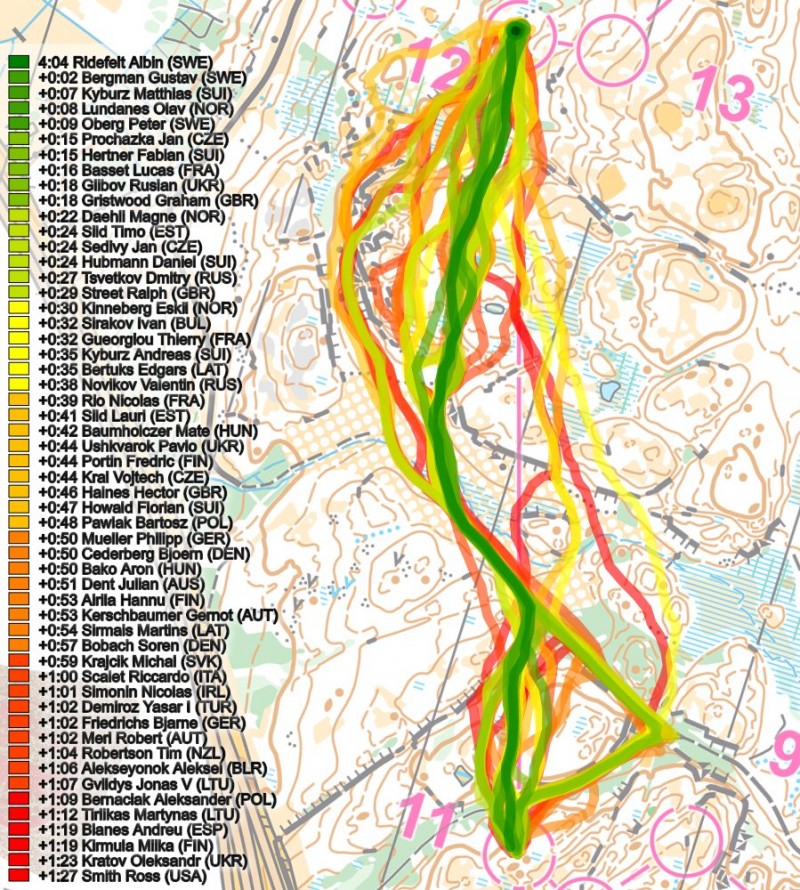
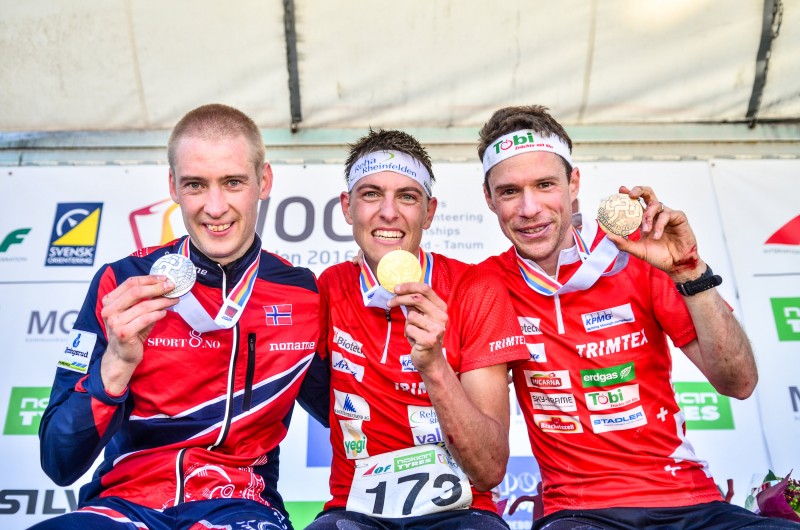

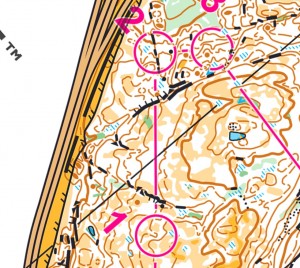
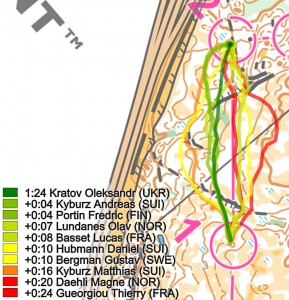
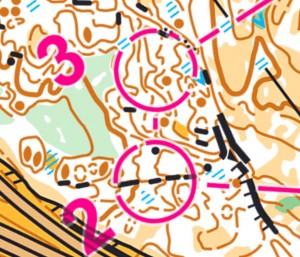
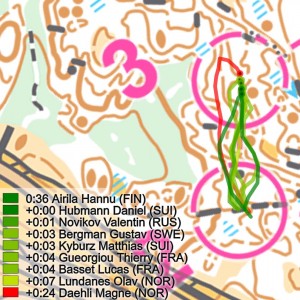
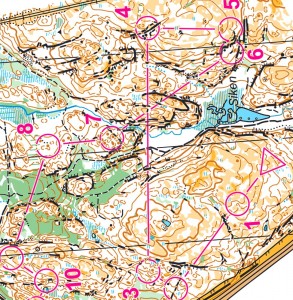
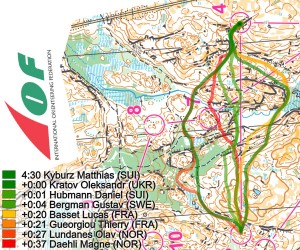
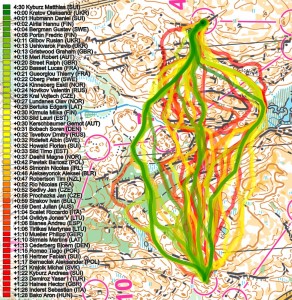
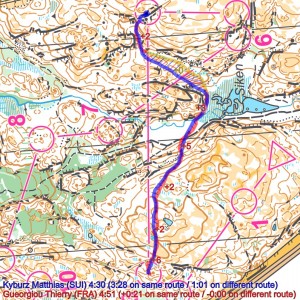
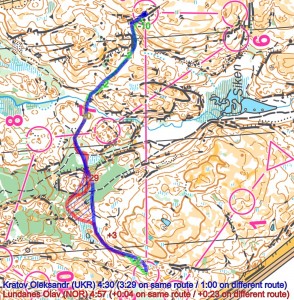
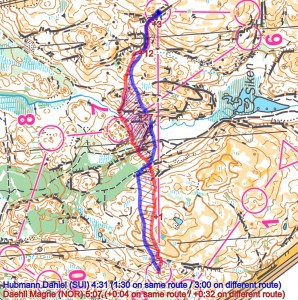
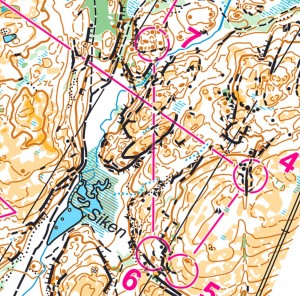
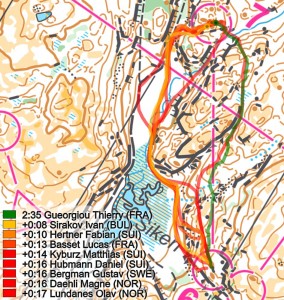

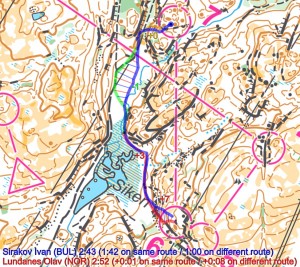
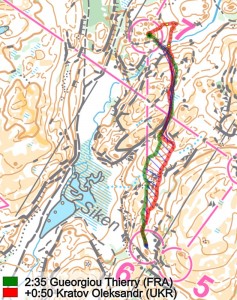
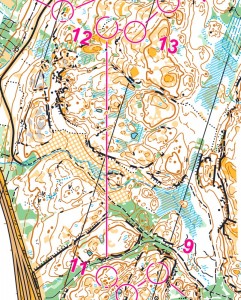


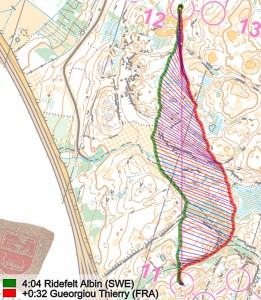

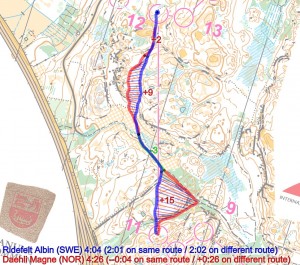
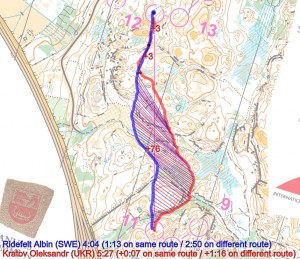
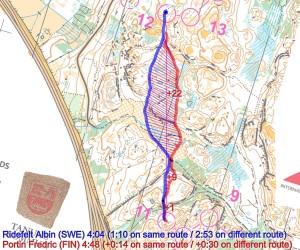
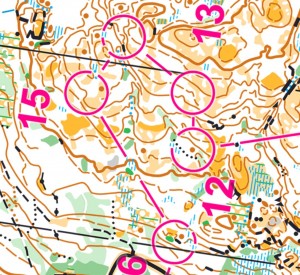
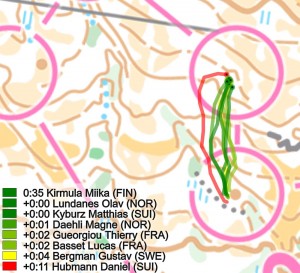

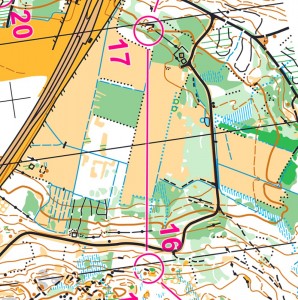

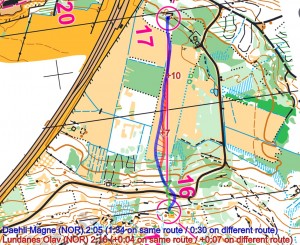

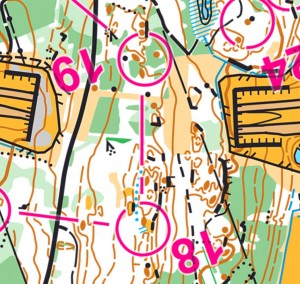

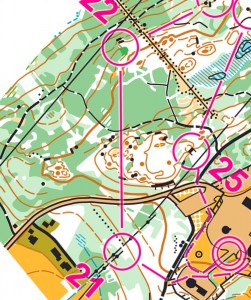
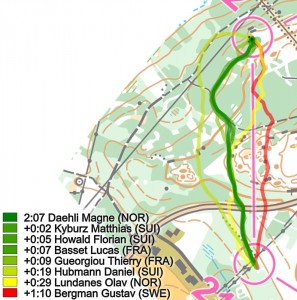
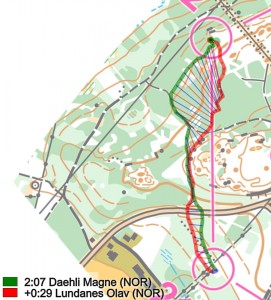
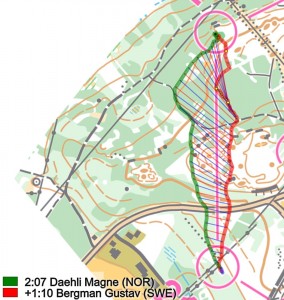
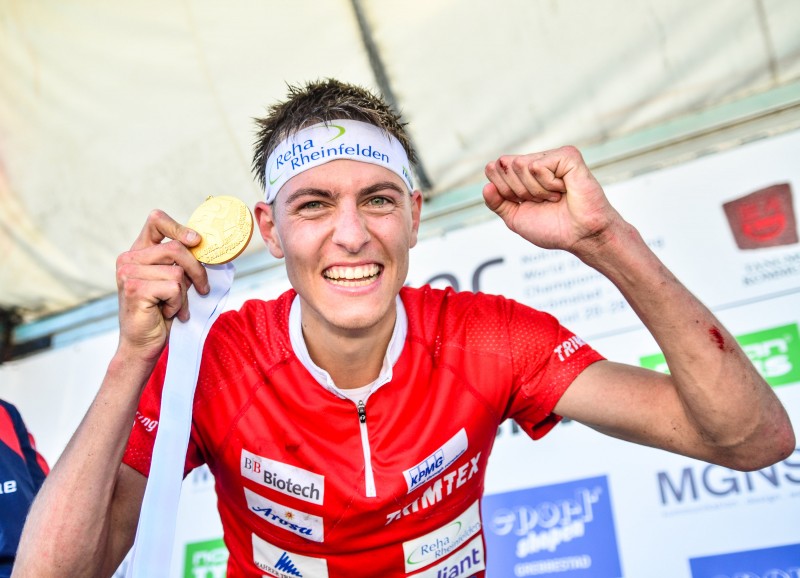
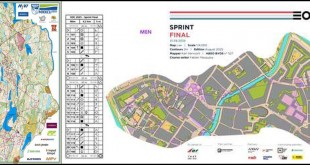
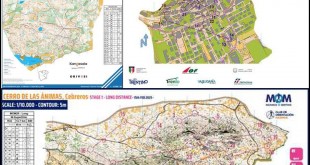


So, basically, the inconsistency in the mapmaking crucially influenced the results. Crap.
For “middle green” the runnability is reduced by 20-60 %, so it is already a big unpredictability there, even when the mapmaking is according to ISOM.
I see your point, but in fact it is not reduced *by* 20-60%, but reduced *to* 20-60% (of the speed in the typical runnable forest), which makes some difference. In particular, it means that on the road it should be at least “almost twice” faster than in middle green. I have not been in the forest, but what I see on GPS, on the way to 9 it was definitely not twice slower in the green than on the road.
Anyway, it is probably more the question of the planning than mapmaking — ideally you should not plan legs such that a runner cannot predict the terrain. At least, you should avoid as much as possible such situations when it can influence the results. That is why leg 16-17 is just rubbish (provided they were not given any additional information beforehand).
As IvarM notes the very wide range for middle green is a real mapping problem!
In an ideal world each vegetation grade would have the same relative distance from the previous, i.e. a geometric scale.
I started writing a long article here but decided to delete it: The key idea is that we want to minimize the ratio from slowest to fastest running that is covered by a single shade, the factor of 3X for the current Middle Green is simply too large!